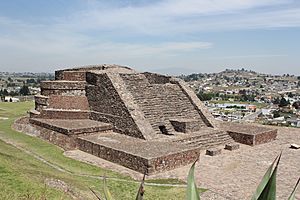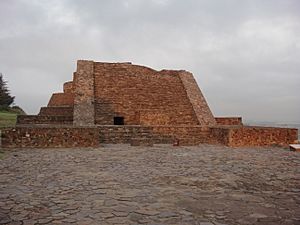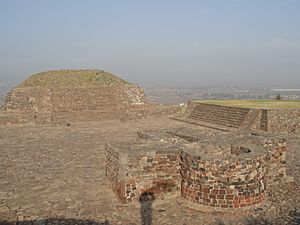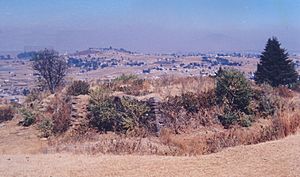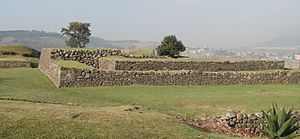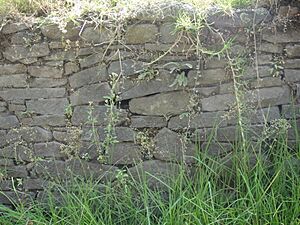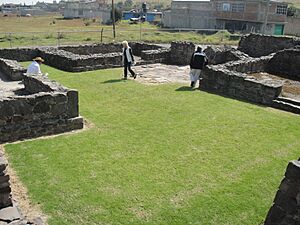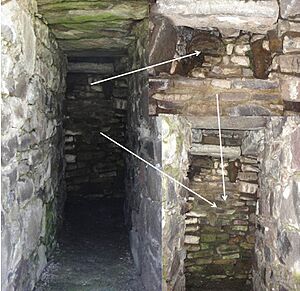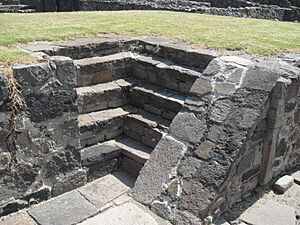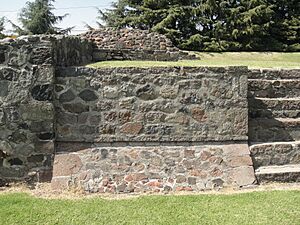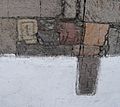Calixtlahuaca facts for kids
Calixtlahuaca is an ancient city site in Mesoamerica, located near the city of Toluca in Mexico. Its name comes from the Nahuatl language and means "place of houses on the plains." This important city was once a powerful capital, and its rulers controlled a large area in the Toluca Valley.
Contents
Exploring Calixtlahuaca
In the 1930s, an archaeologist named José García Payón started digging at Calixtlahuaca. He uncovered and rebuilt many temples and other buildings. Two of the most famous are Structure 3, a round temple for the Aztec wind god Ehecatl, and Structure 17, which was a large royal "palace." The buildings and stone carvings here are similar to other Aztec sites from the Middle to Late Postclassic period (around 1100 to 1520 AD) in central Mexico.
The area of the site has shrunk over time. In 1930, it was about 144 hectares (that's like 355 football fields!), but today it's 116 hectares. Between 1988 and 1998, people worked to protect the site. They added drainage, leveled some areas, put up signs, and tried to stop city growth from damaging it. In 1998, archaeologist Jorge Villanueva Villalpando repaired a wall of Building III that was damaged by storms.
More recently, in 2002, Dr. Michael E. Smith started a new research project. His team began digging in 2006, looking at the entire site. In 2007, they excavated houses and terraces, which helped them understand how the people of Calixtlahuaca lived.
Who Lived Here?
It's thought that the first people to visit this area were nomads, meaning they moved around and only stayed here during certain seasons. Some experts believe that Otomi hunter-gatherers were here as far back as 3,000 years ago, near a lake that has since dried up. Later, the Matlatzinca arrived and built a small settlement. This settlement was influenced by the Toltec culture. Some also believe the Matlatzinca were part of the Nahua family, who had moved into the area earlier.
Around 1476 AD, the Aztecs, led by their ruler Axayacatl, conquered the town of Tecaxic. The Aztecs destroyed the old city and built a new one, which they called Calixtlahuaca. In 1510, the Matlatzinca tried to break free from Aztec rule. But Moctezuma II quickly ordered the city destroyed again, and many people fled west towards Michoacán. Later, different groups repopulated the city, focusing on farming and raising animals.
Battles and Changes
The Matlatzinca lands were important for growing corn. This was a big reason why other groups kept invading the area. First, the Toltecs came, then the Chālcah in the 12th century. The region was divided into three main areas, called Altepetls. Two wanted to stay independent, possibly teaming up with the Purépecha of Michoacán. But the third area, Tollocan, wanted to join the Aztecs. This disagreement caused some Matlatzinca people to move to other regions.
Axayacatl, the Aztec ruler (from 1469-1481), fought against a Mazatleca general named Cuextapalin. Axayacatl was injured in the leg during this battle. Later, in 1474, the Aztecs and their allies from Tollocan fought the Matlatzinca again. They took many prisoners to be sacrificed in Tenochtitlan, which stopped further rebellions in the area. The Aztecs also moved Nahua families to Calixtlahuaca.
From 1482 to 1484, the Matlatzinca tried to rebel again. But the Aztec ruler Tizoc destroyed the Calixtlahuaca temples, marking his victory on a stone. The very last rebellion attempt happened in 1510. Aztec ruler Montezuma II ordered the area destroyed, which led to many people moving away to Michoacán.
Periods of Life at the Site
Archaeologists have found evidence of different times when people lived at Calixtlahuaca:
- Preclassical Period (1500 – 200 BC): Small clay figures and early terraces were found. These were likely made by Otomi groups.
- Classical Period (300 – 600 AD): Pottery from the Teotihuacán culture was found, along with the first stage of Building III. This building was later damaged by an earthquake in 1475.
- Epiclassical Period (900 – 1200 AD): There was a strong Toltec influence, with more terraces and buildings being constructed.
- Postclassical Period (1200 – 1510 AD): This was a time when the Matlatzinca people were very powerful, though they were also influenced by the Aztecs.
The Ancient City Layout
The ancient city of Calixtlahuaca covered about 264 hectares. It spread across the valley floor, most of the Cerro Tenismo hill, and parts of a smaller hill to the east. All the major buildings were constructed during the Postclassical period. Unlike many ancient cities that have one main group of buildings, Calixtlahuaca's large structures are spread out in smaller groups from the valley floor to the top of the hill. The areas between these important buildings were filled with homes for regular people and terraces for farming.
The archaeological site is about 2,500 meters (over 8,200 feet) above sea level. The top of Cerro Tenismo is even higher, at 2,975 meters (over 9,700 feet). At the very top of the hill, there's a natural water spring called Pinalinchini.
Here are some of the main structures found at the site:
Monument 3: The Round Temple
This is a circular building, likely the most important one at the site. It was probably dedicated to the god Quetzalcoatl, who was sometimes shown as a person wearing sandals and a bird-beak mask. Round buildings in Mesoamerica are often linked to Ehécatl, the wind god, because a circle has no beginning or end, just like the gods.
This large circular temple was built in four stages. Archaeologist García Payón found a sculpture of a priest wearing a mask of the god Ehécatl here. This sculpture is one of the most famous examples of Mexica (Aztec) art. The statue was found by chance when workers saw lizards go into some stones. They moved the stones and found the statue.
Monument 4: The Skull Altar
This temple is in a large open area, with a single staircase. It's part of a group that includes a special altar decorated with skulls, known as a tzompantli. This cross-shaped altar had stone skulls carved into it. Originally, there were more than ten, but today only two original ones remain, plus a replica of a third.
Monuments 5 and 7: The Pantheon
These structures are also called the Pantheon. About 50 human burials were found here, along with offerings like gold, pottery, obsidian rocks, and arrowheads. These buildings were built on a large terrace. They were restored between 2002 and 2004.
Monument 16: The Ballgame Court?
This monument includes the remains of a large basement, about 85 meters wide and 100 meters long. García Payón found a round stone with a hole in the center, similar to those found in ancient ballgame courts. He thought this might have been a ballgame court, but more exploration is needed. It's located about 500 meters north of Temple 3.
Monument 17: The Royal Palace
Monument 17 is actually a large complex of buildings. Although García Payón thought it was a "Calmecac" (a school and home for priests), it's now believed to have been the city's Royal Palace. It looks similar to other Aztec palaces.
This complex has 32 rooms, an original adobe (mud brick) wall, and was built in three different stages. It has inner hallways and stairs connecting different levels. Visitors can see four main parts: a residential area, a ceremonial area with a main temple, a wide plaza in front, and bases on the west side.
Residential Area
This part of the complex was likely where people lived. It's divided by an adobe wall, probably built during the last Aztec period. It has three entrances and corridors that lead to different parts, including a private housing area with rooms around an inner courtyard.
Rooms
All the rooms had floors covered in stucco (a type of plaster), built over gravel. Each room also had a square hole in the floor with charcoal remains. These holes were probably used for heating, cooking, or burning Copal (a type of incense) for rituals.
Private Quarters
This area was likely the royal residence for the city's main ruler. It has 7 rooms around a private patio and its own entrance. The rooms are different sizes and were used for different purposes.
Main Temple
This temple has a ceremonial plaza and three staircases to reach the top. The central staircase is about 10 meters wide, and the side staircases are 6 meters wide. It's thought that there were at least three temples on top of this structure. Archaeologists have made an "exploration entrance" on the north side, which shows that the building was constructed in three stages. It has been confirmed that there are no secret chambers or tombs inside this temple.
Western Side Structures
On the west side of the plaza, in front of the main temple, there are several basements with remains of other buildings. There's a staircase called "K" by García Payón and two beautiful "slope-panel" constructions, which are a style seen in Teotihuacan architecture.
Amazing Discoveries
Archaeologists found many interesting objects at Calixtlahuaca. García Payón found burials with pottery similar to vessels from Teotihuacan. There were also five pottery vessels from Oaxaca shaped like jaguar paws, and one with a Zapotec symbol. These finds show that people traded important goods between these regions during the Classical and Postclassical periods.
Pottery and Figurines
The largest group of pottery objects found are "Malacates," which are spinning tools. More than half of them are large ones used for spinning maguey (agave) fiber. Three types of figurines were identified:
- Aztec-style figurines from the Valley of Mexico and Morelos, but made with local clay.
- Aztec-style figurines made with the typical orange clay from the Valley of Mexico (meaning they were imported).
- Unclassified figurines that are likely local styles.
Stone Tools and Objects
There are 32 tools used to remove fibers from maguey plants. These tools are common in burials from the Postclassical period in the Toluca Valley. There are also stone hands and boxes. Only 20 carved stone tools were found, made from flint and obsidian.
Copper and Bronze
A large collection of 81 copper objects was found at Calixtlahuaca. This is one of the biggest collections outside the Purépecha Empire's territory. Most of these are rattles, and they look like bronze objects made in western and central Mexico during the Postclassical period.
Beads and Shells
Archaeologists found 366 green glass beads and 23 shell objects with holes, likely used as jewelry or decoration.
Stone Sculptures
The sculpture of the god Ehécatl is very famous. Another well-known sculpture is of the goddess Chalchiuhtlicue, which is now displayed in the National Museum of Anthropology in Mexico City. But there's also a large collection of 275 other stone sculptures from Calixtlahuaca. Many are in the Aztec style, while others, including many reliefs, have a different style, probably local to the Toluca Valley.
Sacrificial Stones
Two similar stones were found. One, with a curved top, is in the church of St. Francis of Assisi in Calixtlahuaca. The other, with a flat top, is in the Toluca Museum. These stones were likely used for sacrifices.
Petroglyphs
When the St. Francis of Assisi church was built in Calixtlahuaca, stones from the ancient site were used. Some of these stones have carvings, called petroglyphs, which can still be seen on the church's outer walls.
Images for kids
The Calixtlahuaca Head
Calixtlahuaca is also famous for a small clay head, sometimes called the "Tecaxic-Calixtlahuaca head." It was found during García Payón's excavations in the 1930s and some people believe it might be from Ancient Rome. Even though tests and style analysis seem to support its age, most experts on Mesoamerican history are still unsure about where it really came from.
See also
 In Spanish: Calixtlahuaca para niños
In Spanish: Calixtlahuaca para niños


